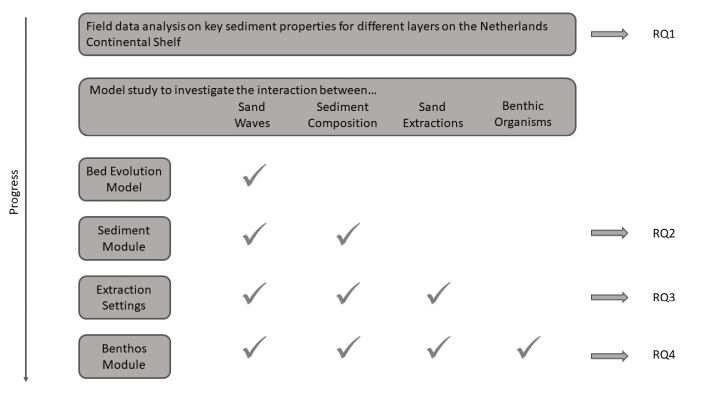W. Ploeg1*, P.C. Roos1, B.W. Borsje1, S.J.M.H. Hulscher1
1 University of Twente, The Netherlands
* Corresponding author: w.ploeg@utwente.nl
Introduction
Due to rising sea levels, the amount of sediment extracted from the Netherlands Continental Shelf (NCS) is expected to (at least) double for coastal defence in 2100 compared to the current extraction rates (Deltacommissie, 2008). To make more efficient use of the limited space and sediment supply on the NCS, a new extraction strategy has been formulated that focuses on deep extractions (MIenW et al., 2014). In line with this, the average extraction depth increased to eight meters in the past decade (MIenW et al., 2022). The impact of these pits may be profound: bed features like sand waves may not recover after dredging (Krabbendam et al., 2022), sediment properties may change to contain finer and more cohesive sediments and the benthos are likely to be affected directly and indirectly due to the extraction (Witbaard & Craeymeersch, 2023). However, present studies were all constrained to a single component of the system or studied the coupled system from observations. Therefore, this study aims to explore and predict the coupled interactions between bed forms, sediment composition and benthic organisms and their response to deep sand extraction.
Objective and Methods
Two idealised, process-based numerical models are employed to unravel key interactions in the coupled system and to explore the influences of various pit design parameters on these dynamics. Firstly, a linearized model is applied to investigate the formation stage of sand waves, exploring how cohesive sediment influences sand wave formation and vice versa (see e.g. Van Oyen & Blondeaux, 2009). Secondly, a (non-linear) idealised model is applied to investigate the decadal evolution of sand extractions and the interaction with benthic organisms and cohesive sediments (see e.g. Damveld et al., 2020). Additionally, we aim to apply numerical bifurcation analysis to both models to allow for the identification of key tipping points and changes in the dynamics within the system.
Results
These models will be applied to unravel the key biogeomorphological processes in response to deep sand extraction, with a particular focus on the coupling between the various system components: how does sediment composition affect sand wave formation and dynamics? What is the impact of deep sand extraction on sea bed morphology and sediment composition? And how does sand extraction impact the spatio-temporal benthic species distribution and the subsequent morphodynamic evolution? As part of the NWO-funded OR-ELSE project, this study also delivers to and contributes from research into other impacts of deep sand extractions, such as impacts on basin-scale flow patterns, habitat-suitability and population dynamics.

Schematic visualisation of the structure of this study. The first research question addresses data analysis of existing data to explore sediment properties on the NCS. The second to fourth question are modelling steps that expand on one another to explore the interaction between sand waves, sediment composition (RQ2), sand extraction (RQ3) and benthic organisms (RQ4).
References
Damveld, J. H., Borsje, B. W., Roos, P. C., & Hulscher, S. J. M. H. (2020). Biogeomorphology in the marine landscape: Modelling the feedbacks between patches of the polychaete worm Lanice conchilega and tidal sand waves. Earth Surface Processes and Landforms, 45(11), 2572–2587. https://doi.org/10.1002/esp.4914
Deltacommissie. (2008). Samen werken met water: Een land dat leeft, bouwt aan zijn toekomst.
Krabbendam, J. M., Roche, M., Van Lancker, V. R. M., Nnafie, A., Terseleer, N., Degrendele, K., & De Swart, H. E. (2022). Do tidal sand waves always regenerate after dredging? Marine Geology, 451, 1–8. https://doi.org/10.1016/j.margeo.2022.106866
Ministerie van Infrastructuur en Waterstaat, Ministerie van Landbouw. Natuur en Voedselveiligheid, Ministerie van Economische Zaken en Klimaat, & Ministerie van Binnenlandse Zaken en Koninkrijksrelaties. (2022). Programma Noordzee 2022-2027.
Van Oyen, T., & Blondeaux, P. (2009). Tidal sand wave formation: Influence of graded suspended sediment transport. Journal of Geophysical Research: Oceans, 114, C07004, 1–18. https://doi.org/10.1029/2008JC005136
Witbaard, R., & Craeymeersch, J. (2023). Littekens op de zeebodem. Een onderzoek naar de faunistische effecten op lange termijn van diepe zandwinning voor de Nederlandse kust (2023–01; pp. 1–42). Netherlands Institute for Sea Research (NIOZ). https://doi.org/10.25850/nioz/7b.b.8d


